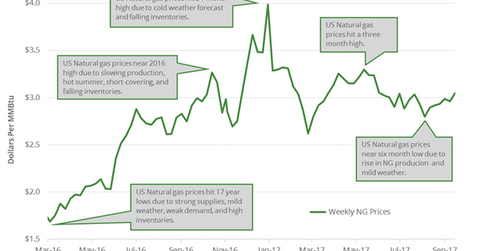Why US Natural Gas Futures Hit a 2-Week High
US natural gas (DGAZ)(UGAZ)(UNG) futures contracts for October delivery rose 0.32% to $3.07 per MMBtu (million British thermal units) on Thursday, September 14.
Sept. 15 2017, Published 3:35 p.m. ET

Natural gas futures 
US natural gas (DGAZ)(UGAZ)(UNG) futures contracts for October delivery rose 0.32% to $3.07 per MMBtu (million British thermal units) on Thursday, September 14. Natural gas prices are at a two-week high due to short covering.
Higher natural gas prices have a positive impact on natural gas producers’ profitability, including Rice Energy (RICE), EQT (EQT), WPX Energy (WPX), and Gulfport Energy (GPOR).
Natural gas and S&P 500 performance this year 
US natural gas (BOIL)(GASL)(FCG) futures are down 14.34% year-to-date due to mild US weather and a rise in US natural gas production. However, the S&P 500 (SPY)(SPX-INDEX) has risen 11.47% year-to-date. Crude oil and natural gas–producing companies are major parts of the energy sector. The energy sector, in turn, contributed to ~5.8% of the S&P 500 on September 14. The energy sector is down 8% year-to-date. So the energy sector has likely been a drag on the S&P 500 so far in 2017.
Highs and lows 
NYMEX natural gas active futures prices hit $1.68 per MMBtu on March 4, 2016—the lowest level in 17 years. Prices fell due to oversupply, mild weather, weak demand, and high natural gas inventories.
NYMEX natural gas active futures hit $3.99 per MMBtu on December 28, 2016—the highest level in almost three years. Prices have fallen due to cold weather and a fall in US natural gas inventories.
Natural gas traders’ calendar  
Some important events for natural gas traders between September 18 and September 22 are as follows.
- Thursday, September 21: The EIA (or U.S. Energy Information Administration) is scheduled to release its weekly natural gas storage report.
- Friday, September 22: Baker Hughes is scheduled to release its weekly US natural gas rig count report.
Series overview 
In this series, we’ll discuss US natural gas inventories, natural gas rig counts, US natural gas production and consumption, and some natural gas price forecasts.
In the next part of this series, we’ll analyze how US weather could drive natural gas prices.
